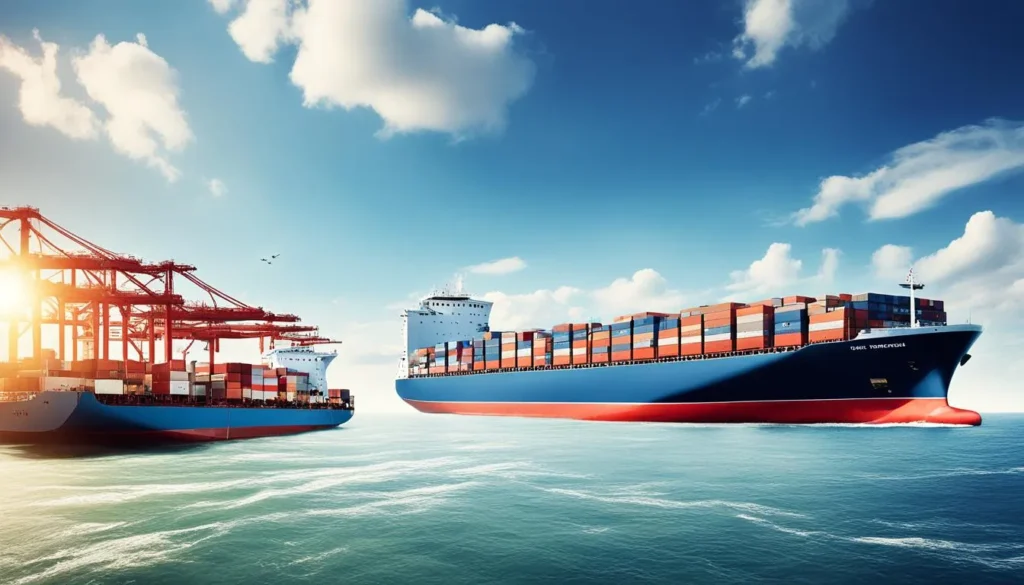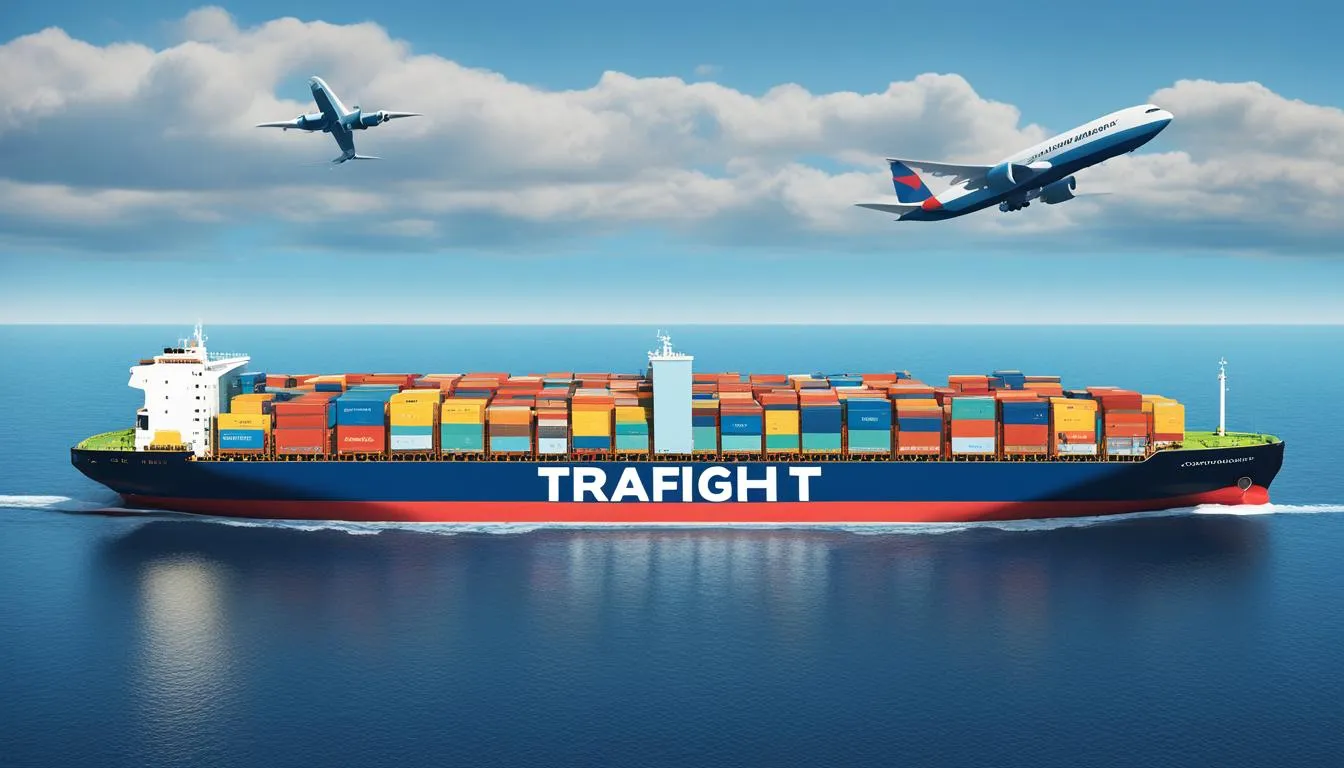As the world grapples with climate change, businesses and consumers are increasingly focusing on the sustainability of their supply chains. Amongst the critical decisions they face is the choice between air freight and sea freight, two dominant forms of transporting goods worldwide. This choice is not only about speed and cost but also concerns the air freight vs sea freight carbon footprint, a significant factor for those looking to reduce their environmental impact. A thorough freight carbon footprint analysis is essential to understanding the long-term implications of these shipping options.
Key Takeaways
- Detailed examination of environmental impacts associated with air and sea freight options.
- Importance of a freight carbon footprint analysis for making sustainable logistic choices.
- Insights on the significant discrepancies in carbon emissions between air freight and sea freight.
- Understanding the role of transportation mode in sustainable supply chain management.
- Discussion on the balance between logistic efficiency and conservation efforts.
Understanding Freight Carbon Footprint
As global commerce expands, the need for comprehensive freight transportation becomes ever more pivotal. However, this growing demand magnifies the environmental concerns associated with the freight carbon footprint. An in-depth examination of the factors influencing freight carbon emissions and the definition of carbon footprint in freight is essential for grasping the relevance of carbon footprint in global shipping.
Definition of Carbon Footprint in Freight
The term ‘freight carbon footprint’ refers to the total greenhouse gas emissions associated with the transportation of goods via air, sea, or land, expressed as carbon dioxide equivalents. This measurement gauges the direct impact of freight operations on climate change, allowing businesses to understand and mitigate their environmental footprint.
Factors Influencing Freight Carbon Emissions
A myriad of factors contributes to the freight carbon footprint. These include but are not limited to, the mode of transportation, the fuel efficiency of the vehicles, the distance covered, the weight and volume of the goods transported, and the entire supply chain’s optimization. For instance, air freight commonly has a higher carbon footprint per ton-mile compared to sea freight, owing to the higher energy intensity of flights.
The Relevance of Carbon Footprint in Global Shipping
Considering the freight carbon footprint is crucial when acknowledging global shipping’s role in contemporary environmental challenges. As international trade routes form the backbone of the world economy, the imperative to reduce emissions in this sector becomes paramount to achieving global sustainability targets. Stakeholder awareness and regulatory measures increasingly focus on the imperative to curb these emissions, incentivizing innovations and responsible practices within the industry.
Air Freight vs Sea Freight Carbon Footprint
When it comes to selecting a shipping mode for goods, the air freight vs sea freight carbon footprint comparison is a central point of deliberation. Air freight, renowned for its speed and efficiency, typically generates a significant carbon footprint due to the high energy consumption of aircraft. In contrast, sea freight, with its slower pace, is often seen as a more carbon-efficient option. However, the real picture of environmental impact is not black and white and warrants a deeper look.
Understanding the carbon footprint differences between air freight and sea freight involves examining multiple factors, such as fuel efficiency, cargo capacity, and distance traveled. For instance, air freight is less fuel-efficient per ton-mile than sea freight, leading to higher carbon emissions. Nevertheless, the total emissions must be weighed against the urgency and lifecycle of the goods being transported. Perishable goods may necessitate the expediency of air transport despite the carbon cost, while non-perishable items may be better suited for the lower emissions of sea routes.
Every mode of freight transport comes with its own set of environmental challenges and impacts, each affecting the overall carbon footprint in unique ways.
- Speed and Efficiency: Air freight provides quick transit times essential for certain industries, at the cost of higher carbon emissions.
- Fuel Consumption: Sea freight ships have significantly better fuel economy on a per-ton-mile basis, resulting in a reduced carbon footprint.
- Load Capacity: The vast cargo-holding capabilities of sea freight allow for large quantities of goods to be moved with relatively lower emissions per item.
Figuring out the balance between efficiency, cost, and environmental impact is a task that requires careful consideration. The pressing need to address climate change pushes the comparison of air freight vs sea freight carbon footprint to the forefront of logistics strategies. It encourages businesses to assess the trade-offs and their commitment to sustainability while fulfilling market demands.
As industries move forward, the importance of understanding and acting upon the air freight vs sea freight carbon footprint data is not just a matter of regulatory compliance but a step towards environmentally responsible business practices. Among various factors, the carbon footprint of shipping methods plays an increasingly vital role in shaping sustainable supply chains and global trading patterns.
In summary, the comparative analysis of air freight vs sea freight carbon footprint is more than a numerical figure; it’s a reflection of a multifaceted approach to addressing the environmental costs of global transportation networks. Each business must evaluate these modes not only in terms of immediate logistical needs but also considering the long-term health of our planet.
Evaluating Environmental Impact of Air Freight
As global trade accelerates, so does the reliance on air freight to meet the demands of fast delivery. However, the environmental impact of air freight remains a contentious issue, particularly when it comes to greenhouse gas emissions. The sheer efficiency and speed that air transport provides come with an undeniable environmental cost that necessitates closer examination.
Greenhouse Gas Emissions from Air Transport
The greenhouse gas emissions from air transport are substantial contributors to climate change. Airplanes are powered by fossil fuels, and every flight releases significant amounts of carbon dioxide (CO2) and other potent greenhouse gases into the atmosphere. Let’s break down the numbers to better understand the scope of these emissions.
| Aircraft Type | CO2 Emissions Per Passenger-km | Average Annual Emissions (Million Tons CO2) |
|---|---|---|
| Narrow-body jet (Short-haul) | 0.154 kg | 160 |
| Wide-body jet (Long-haul) | 0.114 kg | 440 |
| Cargo aircraft | N/A | 60 |
This table underscores the varying levels of emissions produced by different types of aircraft, demonstrating the environmental impact of air freight on a granular level. Notably, the cargo aircraft emission data are not passenger-specific, but are vital for contextualizing freight transportation’s environmental load.
Efficiency and Speed vs. Environmental Cost
While efficiency and speed are hallmarks of air freight, there is a significant environmental cost for such rapid service. This trade-off is the centerpiece of the debate on sustainable logistics practices.
- Speed and delivery efficiency may justify the use of air freight for time-sensitive goods.
- The high carbon footprint of air transportation suggests a need for critical assessment when choosing this mode of freight.
Considering alternatives such as hybrid-electric technology or investing in carbon offset programs might help alleviate some of the environmental burdens. Nonetheless, the current capabilities for rapid global delivery are primarily tied to traditional fossil fuel-powered aircraft, thus heightening the urgency for innovation and change in reducing the environmental impact of air freight.
Assessing the Carbon Emissions of Sea Freight
The importance of sea freight in global trade cannot be overstated, yet its environmental implications, particularly in terms of carbon emissions, necessitate careful consideration. This section delves into the intricacies of the carbon emissions of sea freight, juxtaposing the environmental footprint of container ships and shedding light on the multifaceted role ocean freight plays in the intricate balance of marine chemistry and health.
Comparison of Container Ship’s Emissions
In a progressive effort to discover a path towards more sustainable shipping practices, a critical comparison of container ship’s emissions is imperative. Not all vessels emit the same levels of carbon—a multitude of factors such as size, fuel type, and efficiency come into play. Recent studies highlight significant variations in emission levels, which push for advancements in ship design and fuel technology.
Role of Ocean Freight in Ocean Acidification
While the focus largely remains on airborne emissions, ocean freight contributes to a less visible yet equally concerning phenomenon: ocean acidification. This process, driven by the absorption of CO2, not only upsets the marine ecosystem balance but also calls into question the role of ocean freight in ocean acidification. Steps toward reducing carbon emissions may thus offer a twofold benefit, impacting both air quality and oceanic health.
Impact of Mode of Transport on Carbon Footprint
Choosing the right mode of transport is a pivotal factor in managing the carbon footprint of freight movements. As businesses strive for sustainability, understanding the emissions associated with transportation becomes crucial. This section analyses the emissions from various transportation modes and examines detailed emissions data per metric ton of freight. The objective is to provide actionable insights into how transport decisions influence overall carbon emissions.
Emissions Per Kilometer of Transportation
The emissions per kilometer of transportation serve as a useful metric to gauge the environmental impact of different modes of transport. By quantifying the carbon released per distance, it becomes possible to ascertain the long-term implications of transport choices on sustainability goals.
Per Metric Ton of Freight Analysis
In assessing the per metric ton of freight analysis, we dive into the emissions from the perspective of cargo volume. Such an analysis offers a granular view of the carbon footprint, revealing the efficiency, or lack thereof, of freight transportation modalities.
| Transport Mode | Emissions per Kilometer | Emissions per Metric Ton |
|---|---|---|
| Air Freight | High | Very High |
| Sea Freight | Low | Low |
| Rail Transport | Medium | Low to Medium |
| Road Transport | High | High |
| Electric Vehicles | Low to Negligible | Variable |
As illustrated by the table, it is evident that modes like sea and rail freight tend to have a lower carbon footprint compared to air and road transport. This draws attention to the importance of strategic planning when determining the impact of mode of transport on carbon footprint for both short-haul and long-distance logistics.
Reducing Carbon Emissions in Freight Transportation
In the battle against climate change, reducing carbon emissions in freight transportation is a significant challenge that the logistics industry faces. The sector is increasingly turning to innovative methods and technologies to spearhead efforts for a greener future. In this context, understanding the strides being made in both air and ocean shipping is crucial to appreciating the advancements and recognizing the path ahead.
Technological Advances in Air Cargo
Air cargo, traditionally seen as a high-emission mode of freight transportation, is undergoing a transformation thanks to technological advances in air cargo. As the industry progresses, pioneering developments such as electric-powered aircraft and more efficient aerodynamic designs are taking center stage. This shift not only promises a reduction in carbon emissions but also sets a new benchmark for air freight operations on a global scale.
Innovations in Ocean Shipping
On the marine front, innovations in ocean shipping are making waves in the quest to minimize environmental footprints. The adoption of fuel-efficient vessels and alternative fuels like LNG and biofuels, alongside technologies such as air lubrication and advanced hull designs, represent a commitment to eco-friendly maritime practices. These innovations are not mere experiments but are becoming the new industry standard for responsible ocean shipping.
| Innovation | Impact on Carbon Emissions | Adoption in Industry |
|---|---|---|
| Electric & Hybrid Planes | Significantly lower emissions during flights | Emerging pilot programs |
| Fuel-Efficient Vessels | Reduced fuel consumption and emissions | Increasingly deployed in commercial fleets |
| Alternative Fuels | Lower carbon output compared to traditional bunker fuel | Gradually integrated, with industry and regulatory support |
| Advanced Aerodynamics | Enhanced efficiency leading to emission reductions | Applied in new aircraft designs |
As we advance, the joint emphasis on reducing carbon emissions in freight transportation through innovative endeavors in both technological advances in air cargo and innovations in ocean shipping marks a positive trajectory towards a sustainable logistics infrastructure. These advancements are not just environmentally imperative but also hold the potential to redefine industry standards while fostering economic viability.
Industry Initiatives for Lower Carbon Freight Shipping
The global freight industry is under increasing pressure to reduce its carbon footprint and contribute to environmental sustainability. A variety of industry initiatives for lower carbon freight shipping are emerging, demonstrating a collective commitment to change. These efforts are critical in paving the way for a more eco-friendly transportation sector, which is instrumental in combating climate change.
Collaborative efforts by major industry players have led to the development of advanced data analysis systems that monitor and manage fuel consumption, resulting in operational adjustments that minimize emissions. Pioneering companies are adopting new technologies such as cleaner-burning fuels and exploring renewable energy sources like wind and solar power to propel their vessels.
Many organizations are engaging in voluntary environmental certification schemes to benchmark their progress and demonstrate their dedication to sustainability. These schemes not only provide transparency but also create competitive advantages for those that achieve high standards in reducing emissions.
Another key element of these industry initiatives includes the design and use of aerodynamic modifications on ships and retrofitting older vessels with newer, energy-efficient technologies. Such modifications enhance fuel efficiency and can significantly lower operational costs, thereby encouraging broader adoption across the industry.
- Real-time Emission Tracking
- Adoption of LNG and Biofuels
- Eco-conscious Route Optimization
- Investment in Carbon Offsetting Projects
On the policy front, many shipping corporations actively participate in international dialogue to influence regulations and practices that promote lower carbon emissions. Through such forums, they can also share best practices and technological innovations that may serve as catalysts for widespread industry reform.
Finally, the transition towards lower carbon freight shipping is gaining momentum with the development of industry standards for measuring and reporting carbon emissions. This standardization is essential in setting benchmarks and goals for emissions reduction, providing a clear pathway towards sustainability.
The move towards industry initiatives for lower carbon freight shipping reflects a growing awareness of the environmental impact of global trade. It showcases the proactive steps being taken by the freight industry to mitigate this impact for a greener future.
Freight Shipping Choices and Sustainability
In a world increasingly focused on environmental conservation, the logistics sector is under scrutiny for its role in sustainability. Making informed freight shipping choices is now more critical than ever, not only for the health of the planet but also for the future of businesses. In this context, assessing the environmental impact of shipping methods is paramount.
Assessing Shipping Method Environmental Impact
The shipping industry stands at the crossroads of efficiency and ecology. A deep dive into the environmental impact of various shipping methods reveals significant differences. Air freight, while speedy, results in a noticeably higher carbon footprint compared to sea freight. Conversely, ocean shipping, often slower, can be a more carbon-efficient option, especially over longer distances.
To effectively assess the impact, businesses can turn to emission calculators and environmental auditing tools which measure the greenhouse gas emissions of different transport modes. These instruments provide tangible data, transforming abstract environmental concerns into measurable metrics that can inform sustainable decision-making. Below is a detailed comparison of the two main shipping methods:
| Criteria | Air Freight | Sea Freight |
|---|---|---|
| Emission Rates | High CO2 per ton-km | Lower CO2 per ton-km |
| Speed of Delivery | Fast | Slower |
| Volume Capacity | Lesser | Greater |
| Economic Cost | More expensive | Cost-effective |
| Sustainability Potential | Depends on technology advancements | Green shipping opportunities |
Long-term Implications for Businesses and Environment
When contemplating long-term implications for businesses and the environment, forward-thinking companies must transcend short-term gains. Sustainability isn’t a mere trend; it’s an evolution in operational thinking and strategy. For instance, investing in sustainable shipping may lead to cost savings through improved fuel efficiency and operational innovation. Furthermore, eco-conscious consumers increasingly favor businesses that demonstrate a commitment to reducing their environmental impact, which can bolster brand loyalty and competitive advantage.
Ultimately, sustainable freight shipping not only helps protect the environment but also embodies a long-term vision for business growth. Such an approach entails understanding and mitigating risks associated with climate policy changes and market shifts towards greener alternatives. Companies that proactively integrate sustainability into their logistics emerge as industry leaders, setting the benchmark for the future of responsible business practices.
Legislative Factors and International Shipping Regulations
The arena of international shipping is significantly shaped by a complex web of legislative factors and international shipping regulations that have long-term effects on the environment. Understanding these legislative mechanisms is crucial for anyone involved in global trade and environmental advocacy.
International Agreements Affecting Freight Carbon Emissions
In an effort to address climate change, various international agreements have put forth standards and goals to mitigate freight carbon emissions.
A prime example is the International Maritime Organization’s (IMO) imposition of sulfur limits in marine fuels, part of the IMO 2020 regulations, scoped to reduce sulfur oxide emissions from ships. Similarly, the Paris Agreement binds countries to national targets for reducing greenhouse gases, with implications for the shipping industry that is integral to the global economy.
Predicted Regulatory Shifts by 2050
Looking towards the future, significant regulatory shifts by 2050 are anticipated as part of global efforts to achieve a sustainable environmental footprint in the face of ever-intensifying climate crises. These predicted shifts are expected to reshape the way the shipping industry operates and compel the sector to adapt to stringent ecological standards.

| Regulatory Aspect | Current Standards | Expected Changes by 2050 |
|---|---|---|
| Carbon Emission Limits | IMO 2020 Sulfur Cap | Net-zero Emissions Goal |
| Alternative Fuel Adoption | Initial Research and Advocacy | Widespread Use of Eco-friendly Fuels |
| Shipping Efficiency Standards | Energy Efficiency Design Index (EEDI) | Enhanced EEDI Requirements |
These expected regulatory evolutions fall in line with a greater global move toward aggressive carbon reduction strategies. Thus, staying abreast of these trends is indispensable for strategic planning in the logistics sector, underscoring the profound impact legislative factors and international shipping regulations will have on the future of freight transportation.
Conclusion
In summation, the analytical comparison between the carbon footprints of air freight and sea freight elucidates the complex interplay between logistics efficiency and environmental stewardship. This article traversed through various facets—from the inherent definitions and factors affecting freight carbon emissions to the tangible impact modes of transport have on our planet. The intrinsic value of this discussion lies not merely in quantifying emissions but in fostering a broader consciousness about the environmental repercussions of shipping choices.
Throughout the exposition, it became evident that although air freight offers rapid transit, it comes at a considerable environmental premium. Conversely, sea freight, while typically more carbon-efficient, is not without its challenges, particularly when considering ocean acidification and other cumulative impacts on marine ecosystems. It is clear that there’s a dire need for technological innovation and industry initiatives to lower the ecological footprint of these essential freight modalities.
The conclusion to draw from this exploration is that decision-makers in the logistics sector, along with consumers, hold the collective responsibility to prioritize sustainability. As we navigate towards a greener future, understanding the air freight vs sea freight carbon footprint is indispensable in making transport choices that reconcile commercial objectives with ecological imperatives. This engagement with carbon footprints is not just an exercise in compliance but a strategic endeavor to ensure the longevity of both the industry and the environment.
FAQ
What is the carbon footprint of air freight compared to sea freight?
Air freight typically has a higher carbon footprint compared to sea freight. On average, air freight produces 6 to 13 times more emissions per unit of cargo compared to sea freight.
What factors influence the carbon emissions in freight transportation?
Several factors influence the carbon emissions in freight transportation, including the mode of transport, distance traveled, cargo weight, and fuel efficiency of the vehicles or vessels used.
Why is it important to consider the carbon footprint in global shipping?
Considering the carbon footprint in global shipping is crucial to address climate change and sustainability goals. The shipping industry contributes a significant amount of greenhouse gas emissions that contribute to global warming and environmental degradation.
How do greenhouse gas emissions from air transport compare to those from sea transport?
Air transport emits higher levels of greenhouse gases compared to sea transport. Air cargo produces approximately 10 to 40 grams of CO2 emissions per metric ton of freight, while sea freight emits around 500 grams of CO2 per metric ton of freight per kilometer of transportation.
How does air freight compare to sea freight in terms of efficiency and environmental cost?
Air freight is known for its efficiency and speed in delivering goods, but it comes with a higher environmental cost due to its higher carbon emissions. Sea freight, although slower, has a lower carbon footprint compared to air freight. Ocean freight emits five times more carbon emissions compared to air freight when it comes to freight transportation, making air freight faster but less carbon-intensive and ultimately better for the environment.
What are the carbon emissions produced by container ships in comparison to other modes of transport?
Container ships tend to have a lower carbon footprint compared to other modes of transport, such as cargo ships or air transport. They emit fewer greenhouse gases per metric ton of freight compared to air cargo and are generally considered a more environmentally friendly shipping method.
What is the role of ocean freight in ocean acidification?
Ocean freight contributes to ocean acidification through the absorption of CO2 emissions by the oceans. Increased CO2 levels in the ocean can have detrimental effects on marine ecosystems and biodiversity.
How do emissions per kilometer of transportation differ between different modes of transportation?
Emissions per kilometer of transportation vary significantly depending on the mode of transport. Air transport generally has higher emissions, while sea freight and other modes, such as rail or road transport, tend to have lower emissions per kilometer.
How can carbon emissions be reduced in freight transportation?
Carbon emissions in freight transportation can be reduced through various initiatives, including adopting more fuel-efficient technologies, utilizing renewable energy sources, optimizing logistics and supply chains, and promoting sustainable practices throughout the industry.
What are some technological advances in air cargo aimed at reducing carbon emissions?
Technological advances in air cargo include the development and use of electric and hybrid planes, more efficient engines, sustainable aviation fuels, and improved aircraft design to reduce fuel consumption and carbon emissions.
What are some innovations in ocean shipping to reduce carbon emissions?
Innovations in ocean shipping include the use of fuel-efficient vessels, alternative propulsion systems such as wind-assisted propulsion, and the exploration of hydrogen and ammonia as potential green fuels for maritime transportation.
What industry initiatives promote lower carbon freight shipping?
The freight industry has various industry-led initiatives and programs aimed at promoting lower carbon freight shipping. These initiatives include collaborations between stakeholders, voluntary environmental certification schemes, and the development of sustainable freight transportation practices.
How do shipping method choices impact the environment?
Shipping method choices have a significant impact on the environment, as they determine the amount of carbon emissions and environmental footprint associated with transporting goods. Consideration of the environmental impact helps businesses and individuals make more sustainable choices in freight transportation.
What are the long-term implications of shipping method choices for businesses and the environment?
Choosing more sustainable shipping methods, such as sea freight, can have long-term benefits for businesses and the environment. It can help reduce carbon emissions, mitigate climate change, and contribute to environmental conservation and sustainability goals.
How do international agreements affect freight carbon emissions?
International agreements, such as the International Maritime Organization’s sulfur limits and the Paris Agreement, play a crucial role in regulating and reducing freight carbon emissions. These agreements aim to establish global standards and regulations to mitigate the environmental impact of the shipping industry.
What are the predicted regulatory shifts in freight transportation by 2050?
Predicted regulatory shifts in freight transportation by 2050 include stricter emission standards, increased use of renewable fuels, and the adoption of alternative propulsion technologies. These shifts are expected to further reduce carbon emissions and promote sustainable freight transportation.




